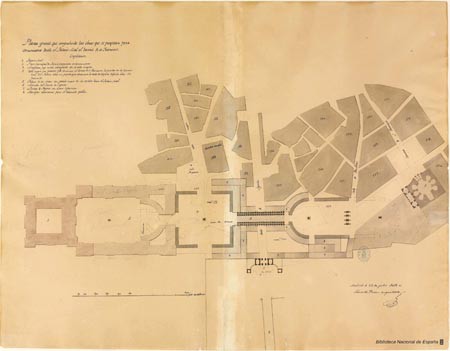Joseph Bonaparte, a new king for Spain
On 20 July 1808, Joseph Bonaparte arrived in Madrid, the capital of what Théophile Gautier was to describe as the most “anti-classical” country in Europe. In comparison with Paris – and even with Naples where Joseph had reigned for two years -, Madrid was a small town that had neither public spaces nor urban infrastructure, its urban landscape seemingly randomly organised and stifled by the overwhelming presence of convents and private domains owned by the aristocracy. Immediately on becoming King, Joseph imposed a new governmental and administrative system which mimicked the French political framework. Although Spain was a satellite state and therefore considered “independent”, nevertheless in 1808 Madrid de facto joined the collective of “imperial capitals” all of which embodied the urban image at the heart of the Napoleon’s grand Europe-wide project. From his arrival in Madrid, Joseph relied on his government ministers to put together an ambitious cultural programme that would include the urban transformation of his capital. Within five years of his reign – and what is more, constantly beset by the economic and social problems caused by a war which exasperated his brother – Joseph Bonaparte had not only managed to build and refurbish many public squares and boulevards, he had also founded new cultural institutions such as the Museum of Paintings, thereby laying the foundations for the future Prado Museum. For the execution of his projects, the King (one of whose nicknames was “plazuelas” or little plazas) employed the two best architects from the architectural academy of Madrid: the well-renowned Juan de Villanueva, and Silvestre Pérez, both of whom were once pensionaries of the Saint Ferdinand Academy of Rome and experts in international avant-garde architecture.
The Forum Bonaparte: from the throne to Utopia
As for his seat of power, Joseph decided to use the Palacio Nuevo, the vast royal residence which had taken thirty years to build and which stood on the site of the Alcazar Royal, the Habsburg royal palace destroyed by the fire of 1734. From his throne there, Joseph played an active role in the debates concerning architectural projects for his capital, ranging from the construction of a commercial exchange to the installation of public fountains in newly built plazas, and even to the creation of public markets, projects that were divided (just like the country) between supporters and critics. The Royal Palace of Madrid, which had so deeply impressed Napoleon during his stay in 1808, was to become the architectural emblem of Napoleonic majesty in Spain. With this in mind, Silvestre Pérez, the capital city’s official architect, proposed an urban-development project to King Joseph in July 1810. The scheme was unique in Spain for three reasons: its sheer size, its symbolic significance, and the scale of the changes it had in store for the kingdom’s capital. One part of this grand project was the Forum Bonaparte, a plan to refurbish the areas surrounding the Royal Palace. Several houses opposite the palace were demolished to open up a large space which would later become the Place d’Orient. Pérez’s project (click here to view an enlargement) comprised the creation of a series of monumental plazas (2, 3, 4) linking the palace (1) to the basilica of St Francis the Great. This latter was to become the first Chamber of the National Assembly in the history of Spain. For Perez, these monumental plazas with their wealth of archways, columns and triumphal arcs, were supposed to create an architecturally symbolic union between the executive power represented by the King’s Palace and the legislative power of the Spanish people present here for the first time, located in what had once been a church of St Francis but which had been converted into a “National Temple” via a Napoleonic policy of national property (biens nationaux). The project likewise highlighted the importance of creating broad access routes to the main parts of the Forum, for example by creating a grand entrance in the form of a triumphant arc for the Avenue de Segovia. Joseph Bonaparte was clearly aware of the project since the plans bear pencil annotations and corrections most likely written by Joseph himself, thereby testifying to his personal involvement in initiatives for the artistic renovation of the city. This bold “antique-style” urban/political scheme which attempted to embody the power and magnificence of the Napoleonic rule in Spain – and which would have radically transformed the dilapidated Alcazar quarter of the city so symbolically linked to the previous royal family of the Spanish Empire – was, however, destined to fail. In a country torn apart by a war that drained the national coffers, such a grand, utopian project was never likely to succeed. And it was definitively abandoned during the absolutist nightmare of the reign of Ferdinand VII, “the longed-for king”.
Adrián Almoguera,
Phd student at the University of Paris IV-Sorbonne / Centre André Chastel
September 2016 (translation Leyly Moridi and Peter Hicks)
Find out more about Joseph Bonaparte : Joseph Bonaparte, Thierry Lentz, éditions Perrin, Paris, 2016, 752 p.


